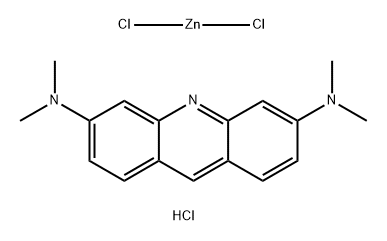A0601212
Acridine Orange hemi(zinc chloride) salt , Electrical , 10127-02-3
Synonym(s):
3,6-Bis(dimethylamino)acridine hydrochloride zinc chloride double salt;3,6-Bis(dimethylamino)acridinium chloride hemi(zinc chloride salt);Acridine orange zinc chloride double salt (C.I.46005);Basic Orange 14
CAS NO.:10127-02-3
Empirical Formula: C17H20Cl3N3Zn
Molecular Weight: 438.1
MDL number: MFCD00081043
EINECS: 233-353-6
| Pack Size | Price | Stock | Quantity |
| 1g | RMB31.20 | In Stock |
|
| 5G | RMB87.20 | In Stock |
|
| 25G | RMB311.20 | In Stock |
|
| others | Enquire |
Update time: 2022-07-08
PRODUCT Properties
| Melting point: | 165 °C |
| bulk density | 200kg/m3 |
| storage temp. | room temp |
| solubility | H2O: soluble1mg/mL, clear, orange to very deep orange |
| Colour Index | 46005 |
| form | Solid |
| pka | pKa -3.3(H2O T=room temperature(RT) Iunspeci?ed) (Uncertain);0.2(H2O T=room temperature(RT) Iunspeci?ed) (Uncertain);10.1(H2O T=room temperature(RT) Iunspeci?ed) (Uncertain) |
| color | Red brown |
| PH | 3.9 (10g/l, H2O, 20℃) |
| Water Solubility | soluble |
| Sensitive | Hygroscopic |
| λmax | 489 nm |
| BRN | 3734978 |
| Stability: | Stable. Incompatible with strong oxidizing agents. Protect from moisture. Hygroscopic. |
| CAS DataBase Reference | 10127-02-3(CAS DataBase Reference) |
Description and Uses
Fluorescent stain for nucleic acids. An RNA polymerase inhibitorAcridine Orange acts as a lysosomal dye. It is used for cell-cycle studies. It plays an important role as a nucleic acid-selective fluorescent cationic dye, which is useful for cell cycle determination. Further, it serves as an inhibitor of RNA polymerase.
Safety
| Symbol(GHS) |  GHS08 |
| Signal word | Warning |
| Hazard statements | H341 |
| Precautionary statements | P201-P202-P280-P308+P313-P405-P501 |
| Hazard Codes | Xn,Xi |
| Risk Statements | 68-20/21/22-36/37/38 |
| Safety Statements | 45-36/37-36-26 |
| WGK Germany | 3 |
| RTECS | AR7600000 |
| HS Code | 32041300 |
| Toxicity | A dye used to stain nucleic acids. It fluoresces at 530 nm when intercalated into double stranded DNA, or at 640 nm when ionically bound to single stranded DNA. It produces mutations, some involving reading frame shifts, other deletions or insertions and is carcinogenic. It is also known to be a dermal phototoxicant. |


